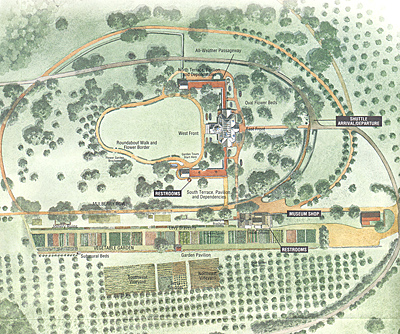 Jefferson's Home
Jefferson's Home
The day we visited Monticello was September 11, 2002. We hadn't planned on being at the home of the principle writer of the Declaration of Independence on the anniversary of 9/11, but we were. It also cost $11 per person to enter, at which point they stopped me from buying a ticket and said I couldn't go in with my camera bag--too big.
Jumbo Monticello Map (extremely slow: 492K)
You know, I'm getting a little tired of the "no bag" policy. Search the thing if you want, but I'd like to have the option to change lenses. No dice. Back to the car I went, and for a moment I thought about getting back in the car and driving down the mountain. But I was here and went back to buy the tickets, though I mentally gave the place one strike. If you're not a camera bug, this shouldn't bother you at all.
Monticello is Italian for "little mountain." A shuttle bus brings you to the top of the hill, depositing you at the front of the house. Uh-oh. It's a guided tour only. Strike two.
Our tour walked up the path to the front steps, first stop in the tour. The guide pointed out various architectural points, noted the house was built over a 40 or so year period, and extolled the cleverness of our third president.
Jefferson Saying
Of note is the anecdote told to me by my father many years ago. Perhaps I should say "motto" rather than anecdote. He told me Jefferson said, "It's amazing how much you can do if you're always doing." I've kind of kept that in the back of my mind all these years. Believe me, many is the time of building MagWeb.com that I came back to that motto.
Now, I never wanted to be told whether it was true or false, as my father was quite fond of making up stories. However, our tour guide related the same "motto" but with a slightly different wording: "It's amazing how much can be done if you're always doing."
Let me tell you what's even more amazing. Since tours are moved through the house with clockwork precision, another guide was taking another group through just as we were sliding across the edge of the Hall into another room. That tour guide said, "It's amazing how much you can accomplish if you're always doing."
Well, well, well. The sentiment's the same, but the words are not. Which one of the three is the real saying? I think it would be amazing if my father was right and the two tour guides wrong.
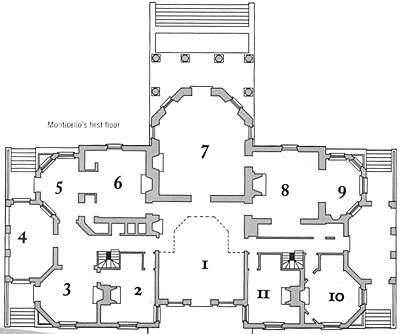 Entrance Hall (1)
Entrance Hall (1)
Inside we went to the Entrance Hall, which served as not only a reception hall, but also as a small museum. A variety of bones and Indian artifacts were hung on the wall or on display in cases. You can't really linger much as tours kept up a pace. Of note is a huge clock on the inside, with the chains holding the weights extending to theleft and right as far as a the wall and descending into the cellar. Days are marked on the wall, with the advance of the weights denoting the day of the week.
Sitting Room (2)
Next was the sitting room, which also served as a schoolroom for Jefferson's daughter and his 11 grandchildren.
Book Room (3)
I'm not sure why they don't call it a library, but Jefferson had 7,000 volumes. In the dim distant recesses of my brain, I believe the Library of Congress was founded by buying a portion of his library--saw that on the tour of the LoC a couple years ago. I remember seeing an exhibit of Jefferson's books in the LoC or one of the Washington DC museums.
Greenhouse (4)
This pleasant place included a workbench for Jefferson to work his horticultural interests.
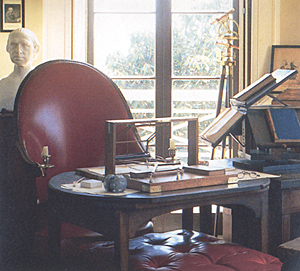 The Cabinet (5)
The Cabinet (5)
Here was the presidential office during the summers of his presidency. He used the colonial equivalent of a copying machine: his pen was attached to an arm extending to another pen. As he wrote with one pen, the other pen duplicated the movements, and thus, he had two letters whenever he wrote one.
Photo of Cabinet from Monticello pamphlet. On the desk is the two-pen writing machine, while to the right is the book holder.
The other item of note in the room is a lazy Susan type of book holder that could hold five books open at a time: one on each side of the square wooden holder and a fifth atop it.
What a deucedly clever fellow this Jefferson was, eh? You could buy a replica book holder in the gift shop, but it costs $400-$500 or so as I recall.
Bedroom (6)
Here he slept and here he died, appropriately, on July 4, 1826, the 50th anniversary of the Declaration of Independence.
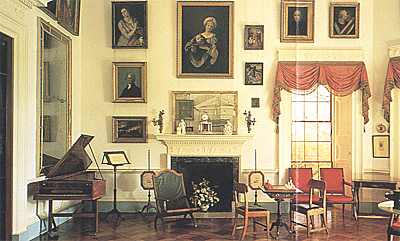 Parlor (7)
Parlor (7)
A reception room and relaxation room that looks out over the back yard. According to the guide, 35 portraits hang on the walls.
Photo of parlor from Monticello pamphlet.
Dining Room (8)
Two meals a day, breakfast and dinner, were served. The kitchens were underneath and dumbwaiters were used, as well as a rotating shelf where additional items could be rotated into the room.
Tea Room (9)
A slightly smaller room off the dining room.
Guest Bedrooms (10, 11)
Nicknamed Mr. Madison's room and Abbe Correia's room after their famous guests, these are simple enough bedrooms.
Second and Third Floors
Forget it. You can't go up. Fire regulations. Since Jefferson regarded stairways as ungainly and a waste of space, the stairs are narrow and steep. I can see how certain tourists would not be able to fit, or worse, become wedged as the stairways circled up. It's still a disappointment. Strike Three for not being able to see the entire house, though I admit when you look at the lowest, oldest, and widest common denominator of tourist, this is not entirely fair. As another president once remarked, "Life's Unfair." The second floor contains a nursery and five small bedrooms, while the third floor contains three more bedrooms and the "dome room" (used as another bedroom or as a storage room).
Outer Buildings
As you exit the home and walk along the deck, the guide pauses to show you a break in the trees. In the distance is the University of Virginia, whose creation is credited to Jefferson. Indeed, he supervised its construction, including the Rotunda, visible from the decking.
The decking forms a big "U," the ends of which include a small house. The eastern building served as Jefferson's house while the rest of Monticello was constructed. Both of these are closed as well, though you can peer inside.
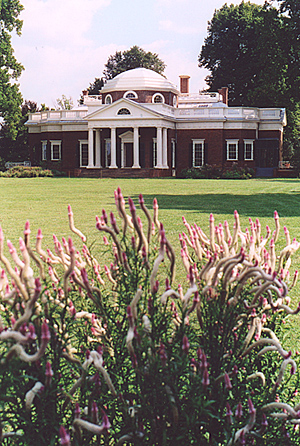 Roundabout Flower Border
Roundabout Flower Border
At that, the tour as over and we could walk around the grounds. We ambled along the pathway circumnavigating the back yard. The flower border was in fine bloom for the most part, and we saw a number of folks from the local gardening society taking care of the plants, which are quite colorful and pleasant to take a stroll around. The plan is based on Jefferson's sketches.
As Jefferson evidently liked efficient use of space, various kitchen, storeroom, and other household functions were in rooms underneath the decking, which also formed a covered walkway under the house. Dumbwaiters were used to bring wine and food up to the dining room on the main floor. Jefferson also must have liked his privacy, because he also installed lazy Susans (though rotating closets might be a better term) to allow food to be "sent" into the dining room without the slaves disturbing the guests.
More Monticello
Back to List of Historic Sites
Back to Travel Master List
Back to MagWeb Master List of Magazines
© Copyright 2003 by Coalition Web, Inc.
This article appears in MagWeb (Magazine Web) on the Internet World Wide Web.
Other articles covering military history and related topics are available at http://www.magweb.com